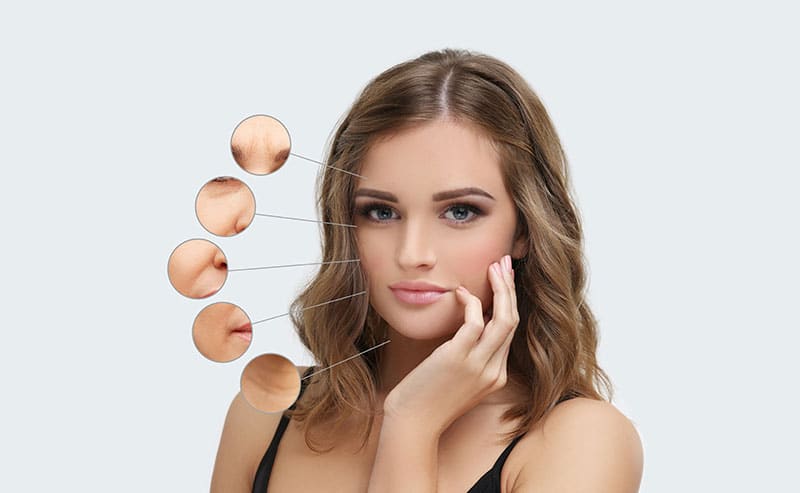In the realm of cosmetic treatments, Botox and dermal fillers have become popular choices for those looking to diminish signs of aging and enhance facial features. While often mentioned together, these two treatments are distinct in their applications and effects.
This blog aims to clarify the differences between dermal fillers and Botox, providing insights into each treatment’s unique characteristics and how they contribute to cosmetic enhancement.
Understanding Botox and Dermal Fillers
Botox, a brand name for Botulinum toxin, is renowned for its ability to smooth dynamic wrinkles—those formed by facial muscle movements like frowning or smiling. In contrast, dermal fillers are substances designed to add volume and smooth out static wrinkles or folds that are visible even when the face is at rest. Common types of fillers include hyaluronic acid and poly-L-lactic acid.
Mechanisms: How They Work:
The primary mechanism of Botox involves blocking nerve signals responsible for muscle contractions. By temporarily paralyzing facial muscles, Botox helps smooth out dynamic wrinkles such as crow’s feet, forehead lines, and frown lines.
Dermal fillers, on the other hand, replenish lost volume and smooth out skin folds. Ingredients like hyaluronic acid not only fill in lines and wrinkles but also hydrate the skin, providing a plumper, more youthful appearance.
Common Uses of Botox and Fillers:
Botox is most effective on dynamic wrinkles, associated with facial expressions, and is commonly used on the forehead, between the eyebrows (for frown lines), and around the eyes (for crow’s feet).
Dermal fillers are versatile and can be used in various facial areas, including treating smile lines (nasolabial folds), marionette lines, and enhancing facial features like lips and cheeks. Fillers can also address issues like lost volume in the face and even help soften the appearance of lower eyelid bags.
The Procedure: What to Expect:
Both Botox and filler treatments are minimally invasive and typically quick, often completed within a single office visit. Botox injections usually take only a few minutes, with no need for anesthesia. The injection site might have minor redness or swelling, but this subsides quickly.
Filler treatments may take slightly longer, depending on the area being treated. Some fillers contain lidocaine, a mild anesthetic, to ensure comfort during the procedure. Post-treatment, patients might experience swelling or bruising at the injection site, which usually resolves within a few days.
In both cases, patients can return to their normal activities the day after the procedure, making these treatments convenient options for those seeking cosmetic enhancements with minimal downtime.
Side Effects and Safety:
Both Botox and dermal fillers are generally considered safe when administered by a qualified professional. However, as with any cosmetic procedure, there are potential side effects to be aware of.
Duration and Maintenance:
The longevity of results varies between Botox and dermal fillers.
Botox typically lasts between 3 to 4 months. To maintain the desired effect, patients will need to schedule follow-up injections. Over time, some patients find they require treatments less frequently as their facial muscles adapt to reduced movement.
Dermal fillers have a longer duration, often lasting from 6 months to over a year, depending on the type of filler used and the area treated. Maintenance treatments are needed to preserve the volume and smoothness provided by the fillers.
Cost Considerations:
The average cost of Botox and fillers can vary widely based on factors like geographic location, the expertise of the practitioner, and the amount of product used.
Botox is usually priced per unit, and the total cost depends on the number of units needed for the desired effect. Treatment of smaller areas like crow’s feet might be less expensive than larger areas like the forehead.
Dermal fillers are typically more expensive per session than Botox because they often require more product per treatment. The type of filler used also influences the cost, with some newer, longer-lasting fillers being more expensive.
Making the Right Choice for You:
Choosing between Botox and fillers depends on your specific cosmetic goals and needs. If your primary concern is dynamic wrinkles caused by facial expressions, Botox might be the ideal choice. Conversely, if you’re looking to restore lost volume or smooth out static wrinkles, dermal fillers could be more suitable.
Consulting with a board-certified dermatologist or facial plastic surgeon gives you the best chance of obtaining your desired outcome. They can assess your skin, discuss your aesthetic goals, and recommend the most appropriate treatment. Remember, it’s not uncommon to use both Botox and fillers in different areas of the face to achieve a comprehensive rejuvenation effect.
The Bottom Line:
While Botox and dermal fillers are both effective cosmetic treatments, they serve different purposes. Botox is primarily used for reducing the appearance of dynamic wrinkles, while fillers are used to add volume and smooth out static wrinkles. Understanding their differences, potential side effects, costs, and maintenance requirements will help you make an informed decision about which treatment is right for you.
As always, consultation with a qualified professional is key to ensuring safe and satisfying results in your cosmetic enhancement journey.

